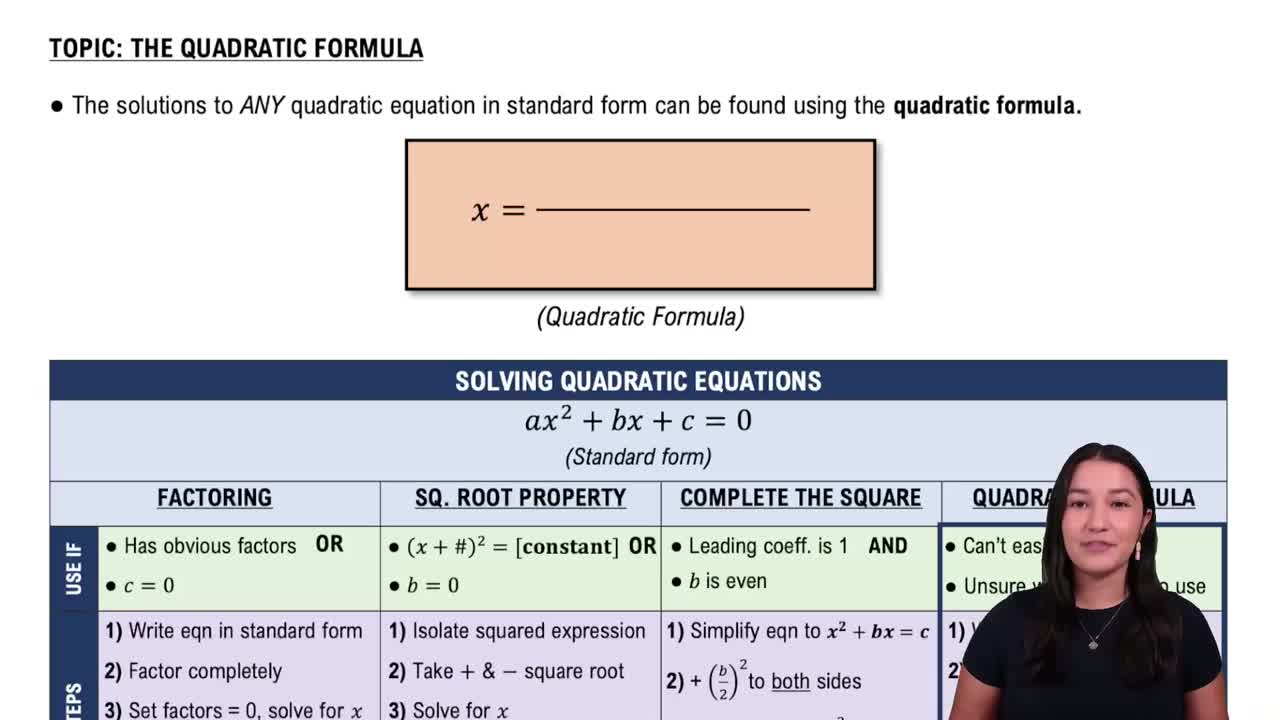Table of contents
- 0. Review of Algebra4h 16m
- 1. Equations & Inequalities3h 18m
- 2. Graphs of Equations43m
- 3. Functions2h 17m
- 4. Polynomial Functions1h 44m
- 5. Rational Functions1h 23m
- 6. Exponential & Logarithmic Functions2h 28m
- 7. Systems of Equations & Matrices4h 6m
- 8. Conic Sections2h 23m
- 9. Sequences, Series, & Induction1h 19m
- 10. Combinatorics & Probability1h 45m
3. Functions
Common Functions
Problem 71
Textbook Question
Graph each function. See Examples 6–8 and the Summary of Graphing Techniques box following Example 9. g(x)=(x+2)^2
 Verified step by step guidance
Verified step by step guidance1
Identify the basic function: The given function is \( g(x) = (x+2)^2 \), which is a transformation of the basic quadratic function \( f(x) = x^2 \).
Determine the transformation: The function \( g(x) = (x+2)^2 \) represents a horizontal shift of the basic quadratic function \( f(x) = x^2 \) to the left by 2 units.
Identify the vertex: The vertex of the basic function \( f(x) = x^2 \) is at the origin (0,0). After the horizontal shift, the vertex of \( g(x) = (x+2)^2 \) is at (-2,0).
Sketch the graph: Start by plotting the vertex at (-2,0). Since the function is a standard parabola opening upwards, plot additional points symmetrically around the vertex to form the U-shape.
Label the graph: Clearly label the vertex and a few other points on the graph to indicate the shape and position of the parabola.
 Verified video answer for a similar problem:
Verified video answer for a similar problem:This video solution was recommended by our tutors as helpful for the problem above
Video duration:
1mPlay a video:
Was this helpful?
Key Concepts
Here are the essential concepts you must grasp in order to answer the question correctly.
Quadratic Functions
A quadratic function is a polynomial function of degree two, typically expressed in the form g(x) = ax^2 + bx + c. The graph of a quadratic function is a parabola, which can open upwards or downwards depending on the sign of the coefficient 'a'. Understanding the general shape and properties of parabolas is essential for graphing functions like g(x) = (x + 2)^2.
Recommended video:

Solving Quadratic Equations Using The Quadratic Formula
Vertex of a Parabola
The vertex of a parabola is the highest or lowest point on the graph, depending on its orientation. For the function g(x) = (x + 2)^2, the vertex can be found by identifying the point where the function reaches its minimum value. In this case, the vertex is at the point (-2, 0), which is crucial for accurately plotting the graph.
Recommended video:

Horizontal Parabolas
Transformations of Functions
Transformations involve shifting, reflecting, stretching, or compressing the graph of a function. The function g(x) = (x + 2)^2 represents a horizontal shift of the basic quadratic function f(x) = x^2 to the left by 2 units. Understanding these transformations helps in predicting how the graph will change from its parent function.
Recommended video:

Domain & Range of Transformed Functions

 5:57m
5:57mWatch next
Master Graphs of Common Functions with a bite sized video explanation from Nick Kaneko
Start learningRelated Videos
Related Practice



